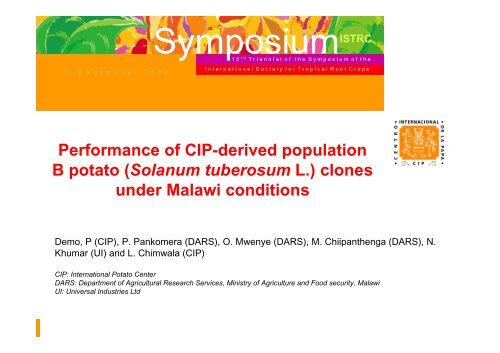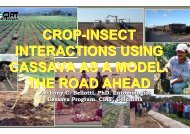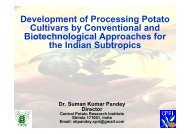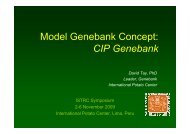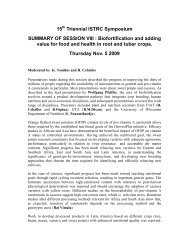Demo, P.; Performance of CIP-derived population B3 potato
Demo, P.; Performance of CIP-derived population B3 potato
Demo, P.; Performance of CIP-derived population B3 potato
You also want an ePaper? Increase the reach of your titles
YUMPU automatically turns print PDFs into web optimized ePapers that Google loves.
SymposiumISTRC<br />
1 5 t h T r I e n n I a l o f t h e S y m p o s I u m o f t h e<br />
I n t e r n a t I o n a l S o c I e t y f o r T r o p I c a l R o o t C r o p s<br />
2 – 6 N o v e m b e r , 2 0 0 9<br />
<strong>Performance</strong> <strong>of</strong> <strong>CIP</strong>-<strong>derived</strong> <strong>population</strong><br />
B <strong>potato</strong> (Solanum tuberosum L.) clones<br />
under Malawi conditions<br />
<strong>Demo</strong>, P (<strong>CIP</strong>), P. Pankomera (DARS), O. Mwenye (DARS), M. Chiipanthenga (DARS), N.<br />
Khumar (UI) and L. Chimwala (<strong>CIP</strong>)<br />
<strong>CIP</strong>: International Potato Center<br />
DARS: Department <strong>of</strong> Agricultural Research Services, Ministry <strong>of</strong> Agriculture and Food security, Malawi<br />
UI: Universal Industries Ltd
OUTLINE<br />
1. Potato production in Malawi:<br />
Strengths, opportunities and<br />
weaknesses<br />
2. Materials and Methods<br />
3. Results<br />
4. Conclusions
Map <strong>of</strong> Malawi showing Locations <strong>of</strong><br />
experiments<br />
D<br />
N
STRENGTHS, OPPORTUNITIES AND WEAKNESSES<br />
IN POTATO PRODUCTION IN MALAWI<br />
STRENGTHS AND OPPORTUNITIES<br />
• Favorable agro-ecological conditions for<br />
production exist in Malawi<br />
2. High value crop with fast tuber bulking and<br />
very high efficiency <strong>of</strong> dry matter production<br />
per unit land area and unit time<br />
3. Very suitable crop for bridging hunger<br />
months (Nov., Dec., Jan., Feb.) when maize<br />
crop is not ready or fails<br />
4. Readily available markets<br />
5. Willingness <strong>of</strong> different organizations to work<br />
together to achieve common goal<br />
6. Growing demand for varieties good for crisps<br />
and French fries by industries and small scale<br />
processors<br />
7. Excellent crop for poverty reduction<br />
WEAKNESSES AND THREATS<br />
1.Lack <strong>of</strong> quality seed <strong>potato</strong> at affordable<br />
price at planting times<br />
2. Use <strong>of</strong> poor tubers storage methods<br />
3. Lack <strong>of</strong> high yielding disease resistant<br />
varieties suitable for different end uses<br />
4. Poor knowledge <strong>of</strong> farmers’, extension<br />
staff and existing research technicians on<br />
improved production techniques<br />
especially on disease<br />
control/management<br />
5. Poor farmers’ organization and poor<br />
marketing system<br />
6. Diseases (Late blight, Bacterial wilt,<br />
Viruses, etc.)<br />
7. Pests (Aphids, cutworms, <strong>potato</strong> tuber<br />
moth, etc.)<br />
8. Shortage <strong>of</strong> qualified technical<br />
personnel for <strong>potato</strong> research and<br />
development
Potato production, Marketing and consumption in Malawi
Materials and Methods<br />
Type <strong>of</strong> experiment: Field trials for evaluation <strong>of</strong> late blight and tuber<br />
yield; Screen house experiment for seed multiplication under aeroponics<br />
Experimental sites and dates: Bembeke, Tsangano and Njuli-Estate in 2008<br />
and 2009<br />
Treatments: Advanced <strong>potato</strong> clones from <strong>CIP</strong>’s Population B materials<br />
Experimental Design: RCBD with 3 replications<br />
Size <strong>of</strong> experimental unit in field: 4 ridges <strong>of</strong> 4 m long each with planting<br />
spacing <strong>of</strong> 80cm x 25 cm (2 middle ridges=net plot)<br />
Major variables measured: Late blight score (% damage), total tuber<br />
number and weight, marketable tuber weight and number, tuber dormancy<br />
period; processing quality<br />
Data analysis: ANOVA with SAS, mean separation with DMRT
RESULTS<br />
Late Blight Resistant clones from <strong>CIP</strong>, 2009<br />
Late Blight damage on the control variety (Lady Rosetta)
Table 1: Total and marketable tuber yield <strong>of</strong> <strong>CIP</strong>-<strong>derived</strong> <strong>potato</strong> clones with genetic traits for durable resistance<br />
to late blight evaluated under field conditions at three different sites (Njuli-Farm, Bembeke and<br />
Tsangano) in Malawi during the summer rain fed seasons <strong>of</strong> 2008 (Feb.-June) and 2009 (Dec.08-Mar. 09).<br />
Clones identities<br />
Njuli-Farm<br />
Total yield<br />
2008<br />
Bembeke<br />
Total yield<br />
Total and marketable tuber yields (Tons/ha)<br />
Bembeke<br />
Total yield<br />
Marketable<br />
yield<br />
2008/2009<br />
Tsangano<br />
Total yield<br />
Marketable<br />
yield<br />
395015.6<br />
34.4ab<br />
21.3 abcd<br />
33.6 a<br />
28.5 a<br />
29.3 a<br />
25.5 a<br />
395111.13<br />
32.7abc<br />
18.9 abcd<br />
19.6 de<br />
17.4 c<br />
19.3 ab<br />
17.2 ab<br />
395011.2<br />
31.4 bc<br />
24.8 a<br />
28.5 abc<br />
24.4 ab<br />
21.1 ab<br />
18.4 ab<br />
396036.201<br />
29.0 bcd<br />
17.7 abcd<br />
26.9 abc<br />
24.4 ab<br />
26.4 ab<br />
22.0 a<br />
391691.96<br />
27.8 bcd<br />
16.8 abcd<br />
32.5 ab<br />
27.8 a<br />
19.6 ab<br />
16.3 ab<br />
396033.102<br />
25.9 cd<br />
15.5 abcd<br />
18.1 e<br />
15.7 c<br />
17.9 ab<br />
15.2 ab<br />
396027.205<br />
21.4 de<br />
19.4 abcd<br />
23.3 cde<br />
21.2 bc<br />
28.3 a<br />
26.3 a<br />
396035.107<br />
-<br />
-<br />
33.3 a<br />
30.7 a<br />
28.0 a<br />
25.2 a<br />
395112.19<br />
39.5a<br />
15.6 abcd<br />
-<br />
-<br />
-<br />
-<br />
393075.54<br />
28.9 bcd<br />
13.7 cd<br />
-<br />
-<br />
-<br />
-<br />
Lady Rosetta<br />
25.9 cd<br />
16.9 abcd<br />
23.3 cde<br />
20.4 bc<br />
16.5 ab<br />
14.2 ab<br />
Rosita (check)<br />
-<br />
-<br />
26.1 bcd<br />
18.2 bc<br />
14.0 b<br />
6.6 b<br />
CV (%)<br />
13.36<br />
20.60<br />
13.82<br />
15.09<br />
29.87<br />
35.27
Table 2: Proportion (%) <strong>of</strong> crop foliage damaged by late blight disease for some <strong>CIP</strong><strong>derived</strong><br />
<strong>potato</strong> clones with genetic traits for durable resistance to late blight<br />
evaluated under field conditions in Malawi during the summer rain fed seasons<br />
<strong>of</strong> 2008 (Feb.-June) and 2009 (Dec. 08-Mar 09)<br />
Clones<br />
identities<br />
395015.6<br />
395111.13<br />
395011.2<br />
396036.201<br />
391691.96<br />
396033.102<br />
396027.205<br />
396035.107<br />
395112.19<br />
393075.54<br />
Lady Rosetta<br />
(check)<br />
Rosita (check)<br />
Proportion (%) <strong>of</strong> crop foliage damaged by late blight disease<br />
2008<br />
2008/2009<br />
Bembeke Bembeke<br />
Tsangano<br />
75 DAP 60 DAP 70 DAP 82 DAP 60 DAP 75 DAP<br />
17.5 c 0.0 b 2.3 cd 14.7 cde 0.0 b<br />
6.7 c<br />
0.2 c 0.0 b 0.7 d 20.0 cd 3.0 b<br />
1.7 c<br />
4.0 c 3.3 b 4.0 cd 10.0 cde 0.0<br />
2.3 c<br />
2.5 c 1.0 b 1.7 d 13.3 cde 1.0 b<br />
4.0 c<br />
1.5 c 0.0 b 0.0 d 0.0 e 0.0 b<br />
1.7 c<br />
0.5 c 0.0 b 11.7 bc 26.7 c 0.0 b<br />
1.3 c<br />
1.0 c 7.3 b 6.7 bcd 16.7 cde 0.0 b<br />
3.3 c<br />
- 0.0 b 0.0 d 3.3 de 0.0 b<br />
2.3 c<br />
0.5 c -<br />
-<br />
-<br />
-<br />
-<br />
2.5 c -<br />
-<br />
-<br />
-<br />
-<br />
87.5 a 48.3 a 100.0 a 100.0 a 26.7 a 100.0 a<br />
- 0.0 b 13.7 b 63.3 b 2.0 b<br />
63.3 b
AEROPONICS TECHNIQUE FOR RAPID MULTIPLICATION OF <strong>CIP</strong>-DERIVED<br />
POTATO CLONES PERFORMS VERY WELL IN MALAWI IN TWO SEASONS<br />
OF TESTING IN PUBLIC-PRIVATE PARTNERSHIP (<strong>CIP</strong>-UI-DARS)<br />
C<br />
A<br />
B<br />
D<br />
A: In-vitro plants after 3weeks in sterilized sand substrate. B: Transplanted plants. C: Grown plants. D: Tubers production in aeroponics box<br />
Partners: <strong>CIP</strong> = International Potato center. UI = Universal Industries Ltd. DARS = Department <strong>of</strong> Agricultural research Services.
Results <strong>of</strong> aeroponics seed multiplication, Malawi, 2009 (cont.)<br />
Survival rate <strong>of</strong> in-vitro plantlets in<br />
sand substrate: 64.5%<br />
Tubers in aeroponics,<br />
Malawi, 2009<br />
Survival rate <strong>of</strong> transplants in<br />
aeroponics unit: 99.75%<br />
Lowest mean No. tubers produced<br />
per plant: 14<br />
Highest mean No. tuber/plant: 41<br />
Mean No. tubers/plant from four<br />
varieties tested: 30 ± 5
Conclusions<br />
1. All <strong>potato</strong> clones evaluated from <strong>CIP</strong>’s <strong>population</strong> B germplasm<br />
were more resistant to late blight than local cultivars Rosita and<br />
the variety Lady Rosetta from South Africa<br />
2. High yielding <strong>population</strong> B clones with resistance to late blight<br />
and good cooking and processing qualities were identified in onstation<br />
trials. These were <strong>CIP</strong>-395015.6, <strong>CIP</strong>-396027.205, <strong>CIP</strong>-<br />
396035.107, and <strong>CIP</strong>-396036.201<br />
3. High performing clones were recommended for on-farm trials<br />
prior to any eventual varieties release<br />
4. Multiplication in aeroponics <strong>of</strong> <strong>potato</strong> clones from <strong>CIP</strong>’s<br />
<strong>population</strong> B (<strong>CIP</strong>-395015.6, <strong>CIP</strong>-393382.44) and A (<strong>CIP</strong>-381381.13,<br />
<strong>CIP</strong>-381381.20) germplasm revealed highest mean multiplication<br />
rate <strong>of</strong> 41 seed tubers per plant from <strong>CIP</strong>-381381.20
Acknowledgements<br />
We acknowledge Irish Aid and USAID/RSA for provision <strong>of</strong> financial<br />
support for the <strong>potato</strong> project under which this study was<br />
conducted<br />
We acknowledge the organizing committee <strong>of</strong> the 15 th Symposium <strong>of</strong><br />
ISTRC for providing the opportunity for this presentation<br />
THANK YOU<br />
FOR<br />
YOUR ATTENTION


